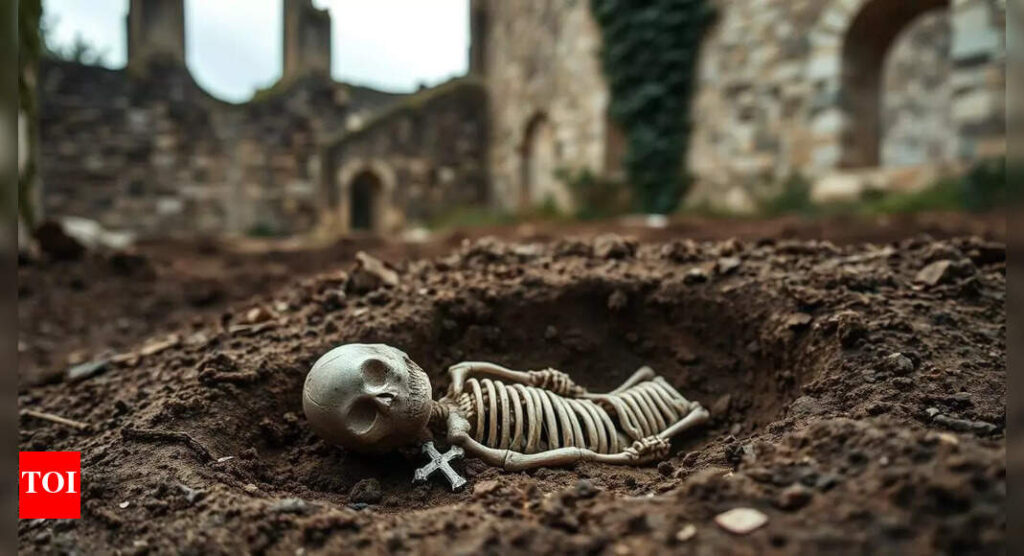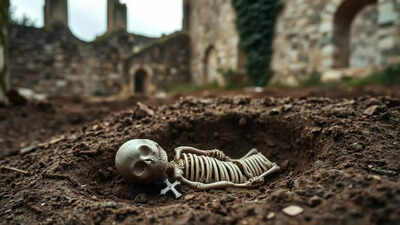Ireland’s chamber of horrors: 800 babies buried in old septic tank; house was run by nuns

In a grim reminder of Ireland’s haunting past, a mass grave containing the remains of up to 800 infants and young children is now being excavated at the site of a former mother and baby home, where today, only a single stone wall remains.Once run by Catholic nuns in a quiet Irish town, the institution’s buried secrets are forcing the nation to reckon with decades of mistreatment and neglect of unmarried mothers and their children, many of whom were reportedly laid to rest in a disused septic tank, the New York Post reported.The burial site is located on the grounds of a former institution run by the Bon Secours Sisters, a Catholic order of nuns, and has become a powerful symbol of Ireland’s dark history of institutional abuse.For decades, unmarried mothers were hidden away in such homes, their children taken from them and left vulnerable to neglect and mistreatment.The existence of the grave first came to light over 50 years ago when two boys stumbled across skeletal remains.But the full scale of the tragedy didn’t emerge until 2014, when local historian Catherine Corless uncovered disturbing records showing that 796 children who died at the home were never properly accounted for.Her research revealed that the remains were likely buried beneath the grounds, specifically inside a defunct sewage tank.Corless’s revelations made global headlines and shocked the nation. Test excavations later confirmed the presence of numerous tiny skeletons inside the tank. Then-Prime Minister Enda Kenny described the site as a “chamber of horrors,” sparking national outrage.Earlier, Pope Francis had publicly apologised for the Catholic Church’s role in the abuse, including the forced separation of mothers and children.The Bon Secours nuns also issued a rare apology, admitting they had failed to uphold Christian values in their care of vulnerable women and children.The mother and baby homes weren’t unique to Ireland—they were part of a wider Victorian-era practice of institutionalizing the poor, unmarried mothers, and vulnerable children.The Tuam home, in particular, was harsh, overcrowded, and deadly. Women were forced to work there for up to a year before being sent away—usually without their children.Accordin to the New York Post, Historian Catherine Corless’ research into Tuam led to a major government investigation, which revealed that 9,000 children about 15% died in such homes across Ireland during the 20th century.Tuam, which operated from 1925 to 1961, recorded the highest death rate.Corless said her determination to uncover the truth grew stronger as she learned more. “The more I realized how those poor, unfortunate, vulnerable kids, through no fault of their own, had to go through this life,” she added.Her research united survivors with relatives who discovered their mothers had given birth to siblings who died in these institutions.Annette McKay noted persistent denial regarding sexual abuse, rape, and incest that led women to these homes, whilst fathers avoided accountability.“They say things like the women were incarcerated and enslaved for being pregnant,” McKay told the Post. “Well, how did they get pregnant? Was it like an immaculate conception?”Her mother entered the home after experiencing sexual assault as a teenager by an industrial school caretaker, where she had been placed for “delinquency” following her mother’s death and father’s abandonment.Margaret “Maggie” O’Connor had earlier revealed this secret only in her seventies, breaking down whilst sharing her story. In 1942, six months post-childbirth at Tuam, whilst at another facility, a nun informed O’Connor, “the child of your sin is dead.”She maintained silence afterwards.Two decades later, McKay spotted a newspaper headline about a “shock discovery” in Tuam. The list included her sister, Mary Margaret O’Connor, deceased in 1943.Barbara Buckley, born at Tuam in 1957, was adopted by a Cork family at 19 months. She learned of her adoption in adulthood through a cousin and later located her birth mother via an agency.Her mother visited from London in 2000, coincidentally during Buckley’s birthday, unaware of the date’s significance.“I found it very hard to understand, how did she not know it was my birthday?” Buckley said. “Delving deep into the thoughts of the mothers, you know, they put it so far back. They weren’t dealing with it anymore.”Her mother worked in the laundry for a year before being dismissed, despite requesting to stay. She remembered only glimpses of sky above high walls.Upon departing, her mother announced she wouldn’t return, citing secrecy concerns.“She said, ‘I don’t want anyone finding out about this,'” Buckley said, the New York Post reported. “Going back to 1957 — and it was still a dark secret,” Buckley added.Pete Cochran considers himself fortunate, having been adopted at 16 months by an American family, avoiding the stigma associated with illegitimacy in Ireland.“I hope they don’t find 796 bodies,” he said. “That all these children were adopted and had a good life like I did.”







